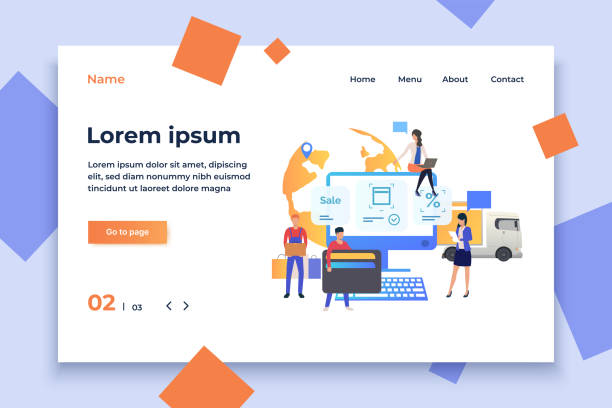The Importance of Secure Website Design in Today’s Digital World

In the current era, as dependence on the internet and online services grows daily, secure website design is no longer an option, but a vital necessity.
This educational and explanatory section helps you understand the depth of this importance.
Every website, from a personal blog to a large e-commerce platform, is a potential target for cyber attackers.
Website penetration not only leads to the loss of sensitive data such as bank card information or users’ personal details but can also irreparably damage a business’s reputation.
Loss of customer trust, heavy legal penalties due to privacy breaches, and even complete operational shutdown are just some of the severe consequences of neglecting website security.
Therefore, a comprehensive approach to website security from the very initial stages of #design and #development is essential.
This approach includes all aspects, from secure coding and selecting appropriate infrastructure to educating users and site administrators.
The ultimate goal of secure website design is to create a reliable and protected online environment for users and businesses.
This not only provides a defensive shield against attacks but also lays a strong foundation for growth and sustainability in the digital space.
Protecting data and ensuring system integrity are the backbone of any online business seeking long-term success.
Are you worried that your company’s old website is driving away new customers? Rasaweb solves this problem with modern and efficient corporate website design.
✅ Increases your brand’s credibility.
✅ Helps attract targeted customers.
⚡ Contact Rasaweb for a free consultation!
Common Website Security Threats and Countermeasures

Understanding common security threats is the first step towards secure website design.
This analytical and specialized section examines some of the most prevalent attacks faced by websites.
One of the most common attacks is SQL Injection, where an attacker gains access to the database by injecting malicious SQL code into website inputs.
Another is Cross-Site Scripting (XSS), where an attacker injects malicious script code into legitimate web pages and gains access to user information.
Denial of Service (DoS) and Distributed Denial of Service (DDoS) attacks cause a website to become unavailable by sending an overwhelming volume of traffic to the server.
Other threats include Cross-Site Request Forgery (CSRF), broken authentication and session management, and the use of vulnerable components.
There are numerous solutions to counter these threats.
For SQL Injection and XSS, strict input validation and the use of Prepared Statements in the database are essential.
For DDoS, the use of CDNs and DDoS protection services is recommended.
Furthermore, implementing strong authentication mechanisms (such as two-factor authentication), proper session management, and regular updates of all website components (content management system, plugins, themes, and server) are vital.
Continuous awareness of the latest vulnerabilities and leveraging security scanning tools are also very effective in maintaining website security.
A proactive and multi-layered approach is the key to success in secure website design.
Principles of Secure Coding and Vulnerability Prevention

Secure coding is the backbone of secure website design, and this guiding and specialized section presents principles and best practices in this area.
The first and most important principle is Input Validation.
All data entering the system from users or external sources must be carefully checked and sanitized to prevent the injection of malicious code or unauthorized data.
This includes checking data type, length, format, and content.
The second principle is the use of Prepared Statements and Parametrized Queries for database interaction, which effectively prevents SQL Injection attacks.
SQL strings should never be built directly by concatenating user inputs.
| Security Principle | Description | Application in Secure Website Design |
|---|---|---|
| Input Validation | Checking and sanitizing all input data before processing or storage. | Prevention of XSS, SQL Injection, and other injection attacks. |
| Use of Prepared Statements | Separating SQL code from data in database queries. | Primary solution for combating SQL Injection. |
| Proper Error Handling | Displaying general error messages to the user and logging details for the system administrator. | Preventing the disclosure of sensitive system information to attackers. |
| Protection against CSRF | Using CSRF tokens in forms and requests. | Ensuring that requests are sent from a legitimate source. |
Furthermore, proper error handling is crucial; error messages should not disclose sensitive system information and should only show general, user-friendly messages, while error details are sent to logs for logging and debugging.
Preventing Cross-Site Request Forgery (CSRF) by using security tokens in forms and requests is also vital.
All these measures, along with OWASP security standards, provide a strong framework for secure website design.
Developers must continuously update their knowledge of web security and use frameworks and libraries that incorporate security principles in their design.
The Importance of SSL/TLS Certificates in Communication Encryption

One of the main pillars of secure website design is the use of SSL/TLS certificates.
This explanatory and specialized section examines how these certificates work and their importance in website security.
SSL (Secure Sockets Layer) and its successor TLS (Transport Layer Security) are protocols that encrypt the communication between a user’s browser and the web server.
This encryption ensures that exchanged data, such as login information, passwords, and credit card details, are protected from eavesdropping, tampering, or forgery by third parties.
The presence of an SSL/TLS certificate is indicated by a padlock icon in the browser’s address bar and the protocol changing from HTTP to HTTPS.
This not only guarantees communication security but also builds user trust, as they become confident that they are interacting with a legitimate and secure website.
From an SEO perspective, search engines like Google prefer websites that use HTTPS in their search rankings.
The choice of certificate type (Domain Validation, Organization Validation, Extended Validation) depends on the needs and the required level of trust.
For large and sensitive businesses, EV certificates, which provide the highest level of assurance, are recommended.
Proper deployment and secure configuration of SSL/TLS, including strong encryption settings and preventing the use of older, vulnerable protocol versions, are an integral part of secure website design.
Given the growing importance of privacy and data security, installing and maintaining an SSL/TLS certificate is an undeniable requirement for any website.
Are you falling behind in the competition with large online stores?
Rasaweb, with professional e-commerce website design, brings your business online and increases your market share!
✅ Increased brand credibility and customer trust
✅ Easy shopping experience leads to more sales
⚡ Act now for a free website design consultation!
Database Security and Injection Attack Prevention

The database is the heart of any dynamic website, and its security in secure website design is of paramount importance.
This specialized and guiding section addresses the necessary measures to protect sensitive data in the database.
Injection attacks, especially SQL Injection, are among the most common and destructive attacks targeting databases.
To prevent these attacks, as previously mentioned, the use of Prepared Statements and Parametrized Queries is vital.
These methods ensure that user input is never interpreted as part of the SQL code.
Additionally, strict validation and sanitization of all inputs at the Application Layer before sending them to the database create an additional layer of defense.
Database access management is also very important.
Never use the Root user or users with excessive privileges to connect to the database via the web application.
Instead, database users should be created with the minimum necessary privileges to perform their specific tasks.
For example, one user just for reading data, and another just for writing.
Encrypting sensitive data in the database, even in the event of a potential breach, can prevent information disclosure.
Using strong encryption algorithms for passwords (such as bcrypt or scrypt) instead of storing plain text or weak hashes, is a fundamental principle.
Regular and secure backups of the database and storing them in separate, protected locations ensure data recovery in case of a disaster.
Secure configuration of the database server and its regular updates are supplementary measures for secure website design and protection of sensitive information.
All these measures together create a strong shield against database security threats.
User Authentication and Authorization

Authentication and Authorization systems play a central role in secure website design.
This guiding and educational section explains best practices in this area.
Authentication is the process of verifying a user’s identity (Are you who you claim to be?) and Authorization is the process of determining a user’s access to specific resources and operations on the website (What can you do?).
For authentication, the use of strong passwords and password complexity policies (including uppercase and lowercase letters, numbers, and special characters) is essential.
Furthermore, implementing Multi-Factor Authentication (MFA/2FA) mechanisms significantly enhances security, as even if a password is compromised, the attacker will not be able to log in due to the need for a second authentication factor.
Secure storage of passwords is also critical; they should be stored using strong hashing algorithms along with a “salt”.
For authorization, the “Least Privilege” model should be followed, meaning users should only have access to resources and operations they need to perform their tasks.
This minimizes the risk associated with compromised user accounts.
Using Role-Based Access Control (RBAC) systems, which grant users access based on their roles, improves efficiency and security.
Also, proper Session Management through the use of secure session tokens, short session durations, and session invalidation after user logout is of particular importance.
Monitoring unsuccessful login attempts and temporarily blocking suspicious accounts can also prevent Brute-force attacks.
By meticulously implementing these principles, secure website design is ensured in the best possible way regarding user access management.
Server and Web Hosting Infrastructure Security

Server and web hosting infrastructure security is one of the most vital aspects of secure website design.
This specialized and analytical section examines server-level security layers that go beyond the website code.
Choosing a reputable and reliable web host with high security standards is the first important step.
This host should have strong firewalls, Intrusion Detection Systems (IDS) and Intrusion Prevention Systems (IPS), and regular backups.
Secure server configuration includes hardening the operating system; that is, disabling unnecessary services, removing vulnerable default programs, and changing default ports.
Regularly updating the operating system, web server (such as Nginx or Apache), and all software installed on the server to address known vulnerabilities is of high importance.
| Security Measure | Description | Importance in Secure Website Design |
|---|---|---|
| Firewall Configuration | Controlling inbound and outbound traffic and blocking unnecessary ports. | First line of defense against network attacks. |
| Regular Updates | Installing security patches for the operating system, web server, and related software. | Closing known security loopholes. |
| Access Control (SSH/FTP) | Using SSH keys instead of passwords, disabling insecure FTP. | Preventing unauthorized access to the server. |
| Log Monitoring | Regular review and analysis of server log files to identify suspicious activities. | Early detection of intrusions or attempted intrusions. |
Furthermore, strict access management to the server, including using SSH with secure keys instead of passwords and disabling insecure FTP, is very important.
The use of Web Application Firewalls (WAF) can also provide a layer of protection against common web attacks such as SQL Injection and XSS.
Monitoring server logs and security monitoring systems is essential for identifying suspicious activities or anomalies.
By implementing these measures, the hosting infrastructure becomes a strong pillar in the secure website design strategy.
The Importance of Security Audits and Continuous Updates

After initial implementation, secure website design is an ongoing process that requires regular audits and updates.
This guiding and informative section addresses the importance of this proactive and reactive approach.
Security Audits and Penetration Testing are vital tools for identifying vulnerabilities and weaknesses in a website before attackers discover them.
These tests can be performed internally by the development team or by external security companies.
Standards such as ISO 27001 provide a framework for information security management.
The results of these audits must be carefully reviewed, and all discovered vulnerabilities should be addressed promptly.
In addition to periodic audits, continuous updating of all website components is essential.
This includes the core of the Content Management System (CMS) like WordPress or Joomla, used plugins and themes, programming libraries, and even the server’s operating system.
Developers of these components regularly release security patches to fix new vulnerabilities, and failure to install these updates means leaving the doors open for attackers.
From an informational perspective, many major cyberattacks have occurred due to the exploitation of known vulnerabilities for which patches were released months or even years ago.
Therefore, establishing a regular update schedule and adhering to it is an integral part of maintaining a secure website design.
These measures not only reduce the risk of attacks but also help businesses comply with data privacy regulations.
Are you losing business opportunities because of an outdated website? With Rasaweb, permanently solve the problem of not attracting potential customers through your website!
✅ Attract more high-quality leads
✅ Increase brand credibility in the eyes of customers
⚡ Get a free corporate website design consultation
Incident Response and Disaster Recovery Plan

Even with the most meticulous secure website design, the probability of a security incident never reaches zero.
This specialized and guiding section addresses the importance of having an Incident Response Plan (IRP) and a Disaster Recovery Plan (DRP).
An IRP is a comprehensive document that outlines the necessary steps to react to a security incident, from identification to containment, eradication, and recovery.
This plan includes defining roles and responsibilities, communication protocols (internal and with external stakeholders such as customers and legal authorities), and step-by-step checklists for handling various types of incidents (e.g., data breach, DDoS attacks, malware infection).
The primary goal of an IRP is to minimize damage from an incident, reduce downtime, and restore operations to normal as quickly as possible.
Alongside an IRP, a DRP is also vital.
A DRP addresses how to recover systems and data after a major disaster (such as server failure, natural disasters, or widespread cyberattacks).
This plan includes strategies for regular backups (data, database, code), backup storage locations (offline or in different geographical points), and their recovery methods.
Regular testing of both plans, especially backup and recovery processes, is crucial to ensure their effectiveness during crises.
Furthermore, training the team to execute these plans under high-pressure conditions is essential.
Having these plans is not only a security requirement but also assures businesses that they will be able to maintain stability and continue operations even in the worst-case scenarios.
This preparedness is an integral part of secure website design and cybersecurity risk management.
The Future of Web Security and Emerging Trends

The world of cybersecurity is constantly evolving, and with the emergence of new technologies, new threats and challenges arise.
This analytical and thought-provoking section addresses emerging trends in the future of secure website design.
One of the most important trends to consider is Artificial Intelligence (AI) and Machine Learning (ML).
Just as these technologies are used to improve cyber defense (such as anomaly detection and threat analysis), attackers also leverage them to develop more sophisticated and automated attacks.
This highlights the need for AI-driven defensive approaches to combat next-generation attacks.
The Internet of Things (IoT) and the increasing number of connected devices significantly expand the attack surface, creating new security challenges for websites and online services.
API (Application Programming Interfaces) security has also gained increasing importance with the widespread adoption of microservices and API-first architectures.
Cloud Security has also become a major concern with the widespread migration of businesses to cloud platforms, as security responsibility in cloud models is often shared between the provider and the client.
The concept of “Privacy by Design”, which emphasizes incorporating privacy from the earliest stages of system design, is also a fundamental approach for the future.
The emergence of quantum computing could also pose challenges for current encryption, although post-quantum cryptography technology is under development.
To maintain a secure website design in the future, organizations must continuously update their knowledge, invest in new security technologies, and adopt a comprehensive and adaptive approach to security that can respond to emerging threats.
Frequently Asked Questions
| No. | Question | Answer |
|---|---|---|
| 1 | What is secure website design? | Secure website design is a process where websites are built with security measures in mind from the early stages of development to protect against cyberattacks, unauthorized access, and data loss. |
| 2 | Why is secure website design important? | Website security is crucial for maintaining user trust, protecting sensitive information (personal and financial), preventing damage to brand reputation, and complying with privacy and security regulations (such as GDPR). A security breach can lead to financial and legal damages. |
| 3 | What are the most common cyberattacks a website faces? | Some of the most common attacks include SQL Injection, Cross-Site Scripting (XSS), Distributed Denial of Service (DDoS), Brute Force, and Credential Stuffing attacks. |
| 4 | What is SQL Injection and how can we prevent it? | SQL Injection is a type of attack where an attacker attempts to manipulate the database or extract information by injecting malicious SQL code into site inputs. To prevent it, one should use Prepared Statements/Parameterized Queries, ORM (Object-Relational Mapping), and strict input validation. |
| 5 | What is Cross-Site Scripting (XSS)? | XSS is a type of attack where an attacker injects malicious scripts (usually JavaScript) into web pages, which are then executed by other users’ browsers. This can lead to the theft of cookies, session information, or alteration of the website’s appearance. |
| 6 | How can Brute Force attacks on login pages be prevented? | To prevent Brute Force attacks, one should use CAPTCHA, limit the number of unsuccessful login attempts (Account Lockout), implement two-factor authentication (2FA), and use complex and long passwords. |
| 7 | What is the role of HTTPS in website security? | HTTPS encrypts the communication between the user’s browser and the website server using SSL/TLS. This prevents eavesdropping, tampering, or forgery of information during transmission and increases user trust. |
| 8 | What is the importance of Input Validation in security? | Input validation is the process of checking and sanitizing data entered by the user. This prevents the injection of malicious code, XSS attacks, SQL Injection, and other vulnerabilities, ensuring that data conforms to the expected format. |
| 9 | Why are regular updates to website systems and software essential? | Regular updates to the operating system, CMS (like WordPress), plugins, themes, and libraries used, fix known security vulnerabilities. Hackers often exploit weaknesses in outdated software to penetrate systems. |
| 10 | What role do regular backups play in secure website design? | Regular and tested backups of website information (database and files) are a vital layer of defense against data loss due to cyberattacks, human error, or hardware failure. This enables quick website recovery in the event of a disaster. |
And other services of Rasaweb Advertising Agency in the field of advertising
Smart Reportage: A dedicated service for increasing website traffic based on real data.
Smart Direct Marketing: Revolutionize click-through rates with attractive UI design.
Smart Custom Software: A fast and efficient solution for improving SEO ranking with a focus on custom programming.
Smart Data Analysis: An innovative platform for improving online growth with attractive UI design.
Smart Social Media: Professional optimization for digital branding using marketing automation.
And over hundreds of other services in the field of internet advertising, advertising consultation, and organizational solutions
Internet Advertising | Advertising Strategy | Advertorial
Resources
Secure Website Design
User Data Protection
The Importance of HTTPS and SSL in Website Security
Common Website Vulnerabilities and Solutions
? Are you ready to transform your business in the digital world? Rasaweb Afarin Digital Marketing Agency smooths your path to online success by providing comprehensive services including professional website design, SEO, and social media management. Build your business’s future with us.
📍 Tehran, Mirdamad Street, next to Bank Markazi, Southern Kazeroon Alley, Ramin Alley, No. 6


